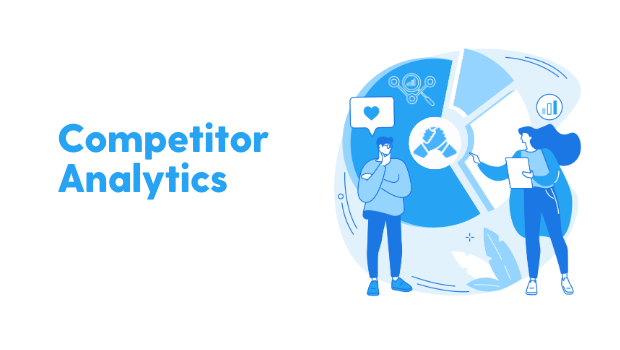Competitor analysis is the process of identifying, evaluating and monitoring the strengths and weaknesses of your competitors. The goal of competitor analysis is to understand how your competitors are positioning themselves in the marketplace, and to identify any potential opportunities or threats to your own business.
This can include analyzing their products, marketing channels, pricing strategies, distribution channels, and other factors. It can also involve understanding their target audience and customer base, as well as their strengths and weaknesses in relation to your own business. This information can then be used to inform your own strategic decisions and improve your competitive positioning.
Competitor Analysis Steps
Broadly, the steps for doing competitor analysis include:
- Selecting the methods to identify competitors
- Tools and Resources to gather information
- Categorizing different types of competitors
- Analyzing competitor data
10 Methods to Identify Competitors
There are several methods that can be used to conduct competitor analysis, including the following:
- Direct observation: This involves visiting the competitor’s physical location and observing their products, prices, and customer service.
- Market research: This involves conducting market research to gather information about the industry, its players, and the target market.
- Social media listening: This involves monitoring social media platforms to track mentions of the company, product or service and its competitors.
- Google Search: you could conduct research using keywords related to your product or service and see the results of the search and the companies that appear on the first page
- Surveys and interviews: This involves conducting surveys or interviews with customers of the competitor to gather information about their perceptions and experiences with the competitor’s products and services.
- Sales data analysis: This involves analyzing the competitor’s sales data, such as their revenue and market share, to gain insights into their performance.
- Patent analysis: This involves analyzing the competitor’s patents to identify their key technologies and possible future product developments.
- News and press release analysis: monitoring and analyzing the competitor’s press releases and news for information about their new products, partnership, mergers and acquisitions, etc.
- Market share analysis is a method of evaluating the relative size of a company’s market as compared to its competitors. This can be useful to identify the leading companies in a market, and how the market share is distributed among the competitors.
- Customer base analysis involves identifying the target market segments and understanding the needs, demographics, and behavior of the customers of the company and the competitors. This can help in identifying the strengths and weaknesses of the competitors’ customer base, and identifying opportunities for the company to target new segments or gain customers from the competitors.
Using a combination of these methods can provide a comprehensive view of the competitor’s strengths and weaknesses and help inform a strategy for competing effectively.
Tools and Resources to Gather Competitor Information
| Tools and Resources | Description |
| Alexa, SEMrush | Online market research tools that provide information on a competitor’s website traffic, keywords, and advertising strategies. |
| Hootsuite, Sprout Social, Buzzsumo | Social media monitoring tools that can help you track competitor activity on social media platforms and identify trends and engagement metrics. |
| Tableau, Power BI, Google Analytics | Business intelligence and data analytics tools that can help you analyze large amounts of competitor data and identify patterns and trends. |
| IBISWorld, Frost & Sullivan, Forrester Research | Industry reports that provide valuable insights into market trends, size, and growth, and the competitive landscape in a particular industry. |
| Company websites and annual reports | Company websites and annual reports provide information on a competitor’s products, services, financial performance, and more. |
| Job portals (LinkedIn, Indeed, Glassdoor) | Gives insight into a competitor’s staffing and hiring trends and can provide insights into their growth and expansion plans |
| News and Media monitoring tools (Google Alerts, Mention) | Helps you stay informed about competitor activities, product launches, and announcements. |
| Consumer feedback and review platforms (Yelp, Trustpilot, ProductReview) | Provides insight into customer perceptions and feedback of a competitors offering |
It’s worth noting that this is not an exhaustive list and there may be other tools and resources available. Additionally, different tools may be more relevant or useful depending on the industry and type of information you are looking to gather.
7 Ways to Categorize Competitors
Here are 7 ways to categorize competitors as part of a competitor analysis:
- Direct competitors: These are companies that offer the same or similar products or services as your business.
- Indirect competitors: These are companies that offer products or services that can be used as an alternative to your business.
- Substitute products: These are products that can be used instead of your own, even if they are not offered by a direct competitor.
- Potential competitors: These are companies that could enter your market in the future and compete with your business.
- Historical competitors: Companies which were your competitors in the past but doesn’t exist anymore.
- Global competitors: Companies which operates outside of your location but still offer similar products or services.
- New market entrants: Companies which are new in your market but offer similar products or services.
Analyzing Competitors
There are several methods for analyzing competitors, including SWOT analysis, PESTLE analysis, Porter’s Five Forces analysis, and analysis of competitors’ strengths and weaknesses.
- SWOT Analysis: SWOT analysis is a method that can be used to identify a competitor’s strengths, weaknesses, opportunities, and threats. This can help you to understand the competitor’s position in the market, and identify potential areas where you can gain a competitive advantage.
- PESTLE Analysis: A PESTLE analysis is a framework for analyzing the external factors that can impact a business, including Political, Economic, Social, Technological, Environmental and Legal factors. This can help you to identify the current and potential impact on the industry and competitors as a whole.
- Porter’s Five Forces Analysis: Developed by Michael Porter, Porter’s Five Forces analysis is a framework for analyzing the competitive dynamics of an industry. It looks at the threats from new entrants, the bargaining power of suppliers and buyers, the threat of substitute products or services, and the intensity of competitive rivalry within an industry. This can help you to identify the relative level of competition in an industry, and potential areas where you can gain a competitive advantage.
- Analysis of Competitors’ Strengths and Weaknesses: In addition to these frameworks, it’s also important to conduct a more detailed analysis of a competitor’s strengths and weaknesses. This can be done by researching a competitor’s products, services, branding, marketing, financial performance and understanding their target market, customer base, etc. This information can be used to identify potential opportunities to differentiate your own products and services and target areas where the competitors may have a weak spot.
It is worth noting that multiple analysis can be used together to get a better understanding of the competitiveness and the industry. Also, competitor analysis should be continuously updated to adapt to changes in the market and the competitors.
Developing a Competitive Strategy
Developing a competitive strategy involves using competitor analysis to inform strategic decision making and identifying opportunities for differentiation.
- How to use competitor analysis to inform strategic decision making: The results of a competitor analysis can be used to inform strategic decision making in a variety of ways. For example, identifying a competitor’s strengths and weaknesses can help you to identify potential areas where you can gain a competitive advantage. Understanding a competitor’s target market and positioning can help you to identify opportunities to reach new customers or expand into new markets. Understanding a competitor’s pricing strategy can help you to develop your own pricing strategy and set prices that are competitive yet profitable.
- Identifying opportunities for differentiation: One of the key outcomes of a competitor analysis is identifying opportunities for differentiation. Once you understand your competitors’ products, services, and strategies, you can identify areas where your own offering can be differentiated. For example, by offering a wider range of products, better customer service, or a more user-friendly website.
- Developing a unique value proposition: A unique value proposition (UVP) is a statement that defines how your product or service is different from and better than those of your competitors. It communicates the unique benefits that your offering provides to customers. A well-crafted UVP can help to differentiate your business and attract new customers.
- Ways to stay ahead of the competition: To stay ahead of the competition, it’s important to continuously monitor the market, keeping an eye on new entrants, new technologies, and changes in consumer behavior, as well as constantly updating your competitor analysis. Additionally, investing in research and development, testing new strategies and constantly looking for ways to improve your product, service, and the overall customer experience can help you to stay ahead of the competition. Moreover, building a strong relationship with your existing customers and keeping a close eye on their feedback and needs, not only helps you retain them but also create word-of-mouth promotion which can attract new customers.
Conclusion
Competitor analysis is a crucial step in the strategic planning process, as it helps businesses understand the competitive landscape, identify areas of opportunity and potential threats, and inform decision-making. By gathering information on competitors’ products, services, pricing, marketing strategies, and strengths and weaknesses, organizations can gain insights into the market and use this information to develop strategies for differentiation and gaining a competitive edge.
Competitor analysis should be an ongoing process, as the market is constantly changing and new competitors can emerge at any time. By regularly monitoring the market, businesses can stay informed of changes and adapt their strategies accordingly.
There are a variety of tools and resources available for conducting competitor analysis, including online market research tools, social media monitoring tools, industry reports, company websites and annual reports, job portals, news and media monitoring tools, and consumer feedback platforms.
Using a combination of different methods and tools, organizations can conduct a comprehensive competitor analysis that will provide a solid foundation for making strategic decisions, building a strong brand, and staying ahead of the competition.
One way to stay ahead of the curve is utilizing the power of data and this is where Saras Analytics can help blow your competition out of the water.













